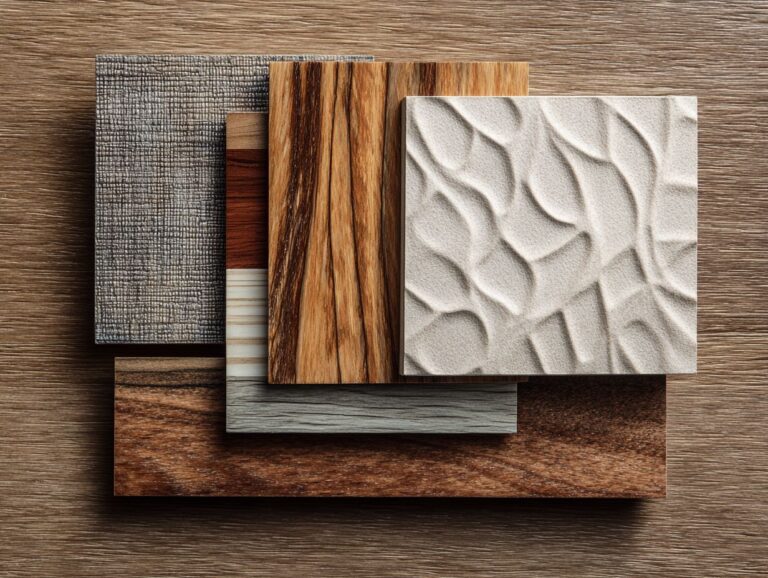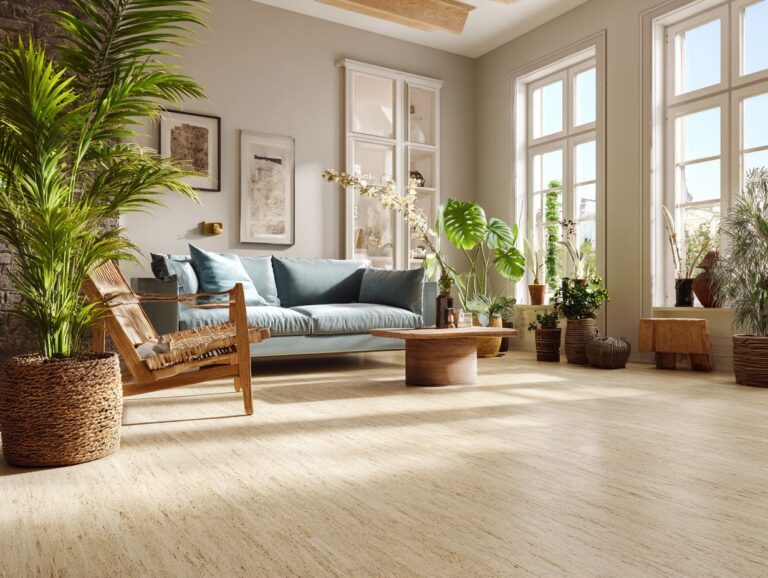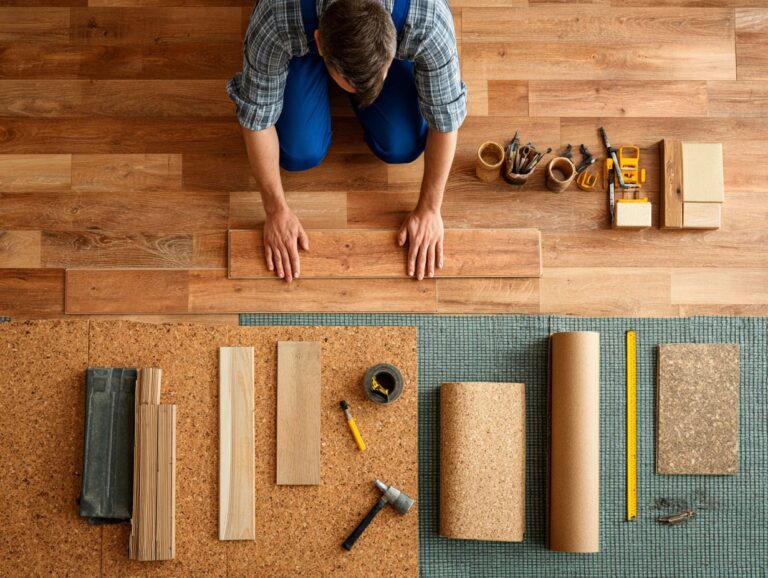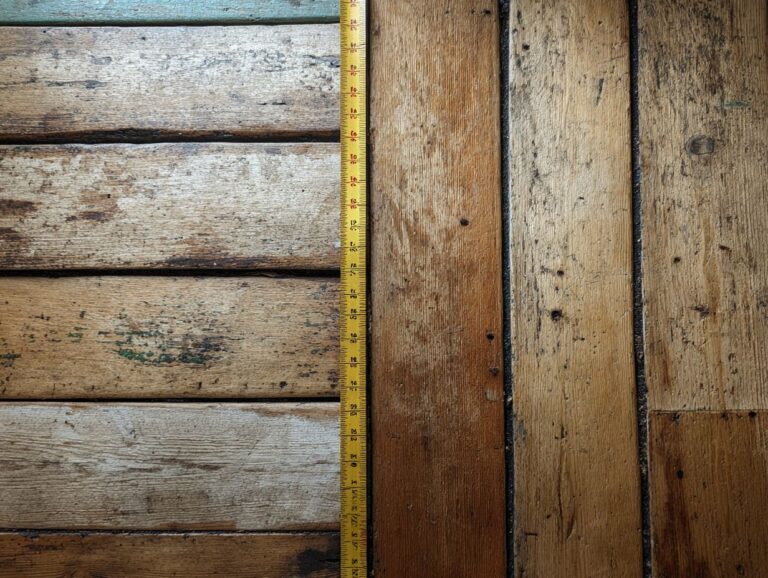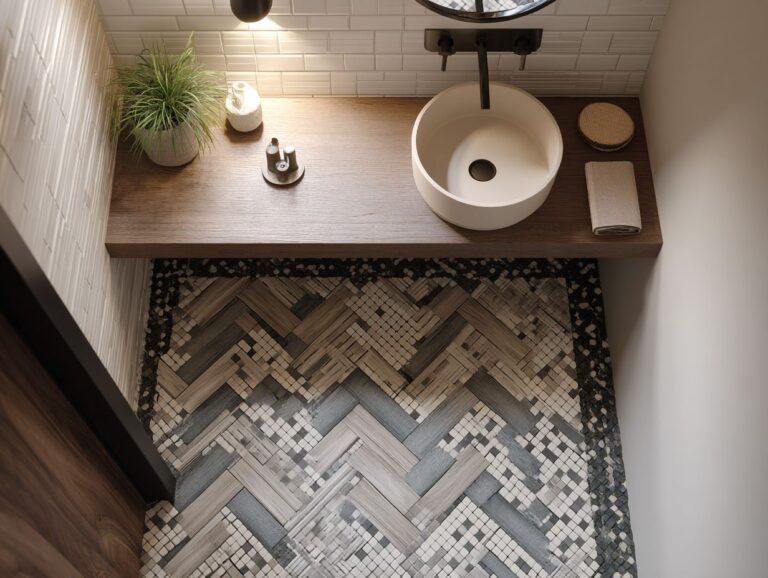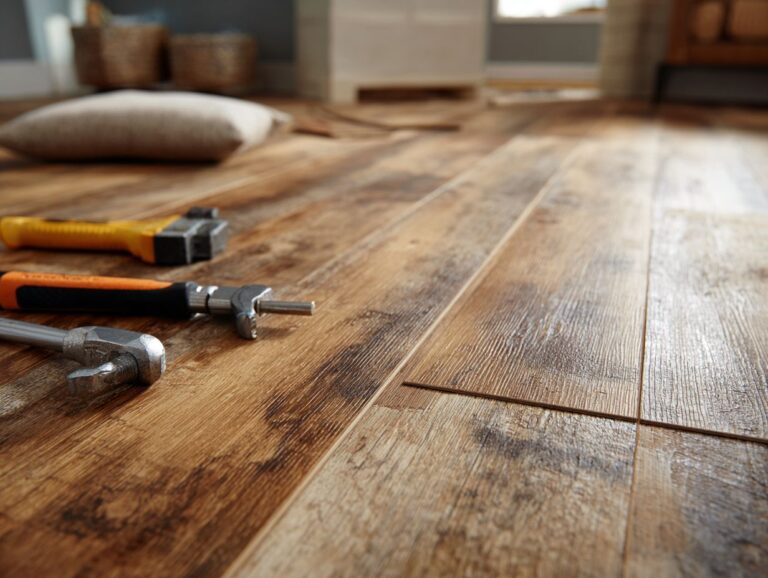Biophilic Design and Natural Flooring Materials
Using biophilic design changes indoor spaces by adding natural elements that improve well-being. By focusing on sustainable materials like hardwood floors, Factory Flooring Liquidators offers innovative solutions for modern interior design. This article looks at the ideas behind biophilic design and the advantages of using natural flooring materials, helping you make a peaceful space that links with nature. Learn how to improve your space and help the environment.
Key Takeaways:
Contents
- Principles of Biophilic Design
- Natural Flooring Materials Overview
- Wood Flooring
- Stone Flooring
- Cork Flooring
- Integrating Natural Flooring in Biophilic Design
- Biophilic Design Market and Economic Impact
- Frequently Asked Questions
- What is biophilic design and how does it relate to natural flooring materials?
- Why is biophilic design gaining popularity in the design world?
- What are some examples of natural flooring materials used in biophilic design?
- Are there any sustainability benefits to using natural flooring materials in biophilic design?
- What should I consider when choosing natural flooring materials for a biophilic design?
- Can biophilic design and natural flooring materials be used in any space?
Definition and Importance
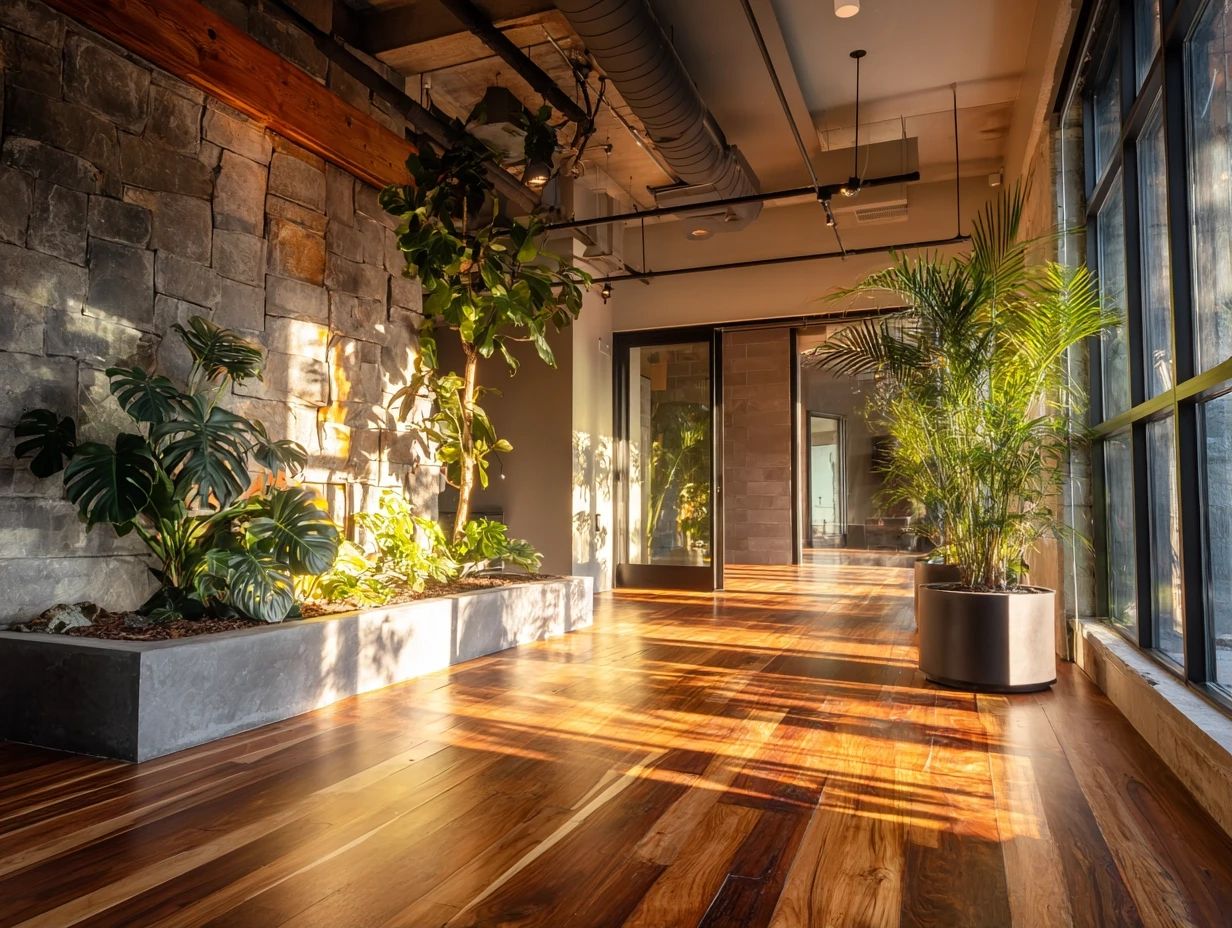
Biophilic design is a method of adding natural features to buildings to improve emotional health and create a stronger link to nature.
This design philosophy is supported by studies, such as those from the NIH, which highlight that exposure to natural environments can significantly improve mood and reduce stress.
For example, incorporating large windows that frame outdoor views or using living walls filled with greenery can create a calming atmosphere.
Statistics reveal a growing preference for homes that include natural aesthetics, with 70% of buyers expressing interest in properties that feature abundant plant life.
Biophilic design meets market demand and improves the health of residents.
Historical Context
Biophilic design began with early architecture concepts that recognized the significant influence of nature on human behavior.
In the 20th century, designers such as Frank Lloyd Wright started including natural elements in their designs. Wright’s `Fallingwater’ exemplifies this by harmonizing with its waterfall surroundings.
Later, companies like Foster + Partners began using this method, concentrating on eco-friendly designs and adding natural features to urban spaces. Their ‘Bloomberg London’ headquarters features a living wall and natural ventilation systems, demonstrating a commitment to biophilia.
This change shows people increasingly recognize how important parks and gardens are for improving well-being, encouraging a better connection between people and their surroundings.
Principles of Biophilic Design
Biophilic design is based on main principles that focus on using elements from nature to create peaceful and welcoming spaces.
Natural Elements
Using natural elements like wood, stone, and plants improves visual appeal and creates a feeling of calm and peace.
To achieve this, consider using reclaimed wood for furniture, which adds character and history, or opt for stone accents in your decor.
Big indoor plants, like fiddle leaf figs or snake plants, can improve air quality and serve as an eye-catching centerpiece. For instance, a minimalist room with a wooden coffee table, a stone feature wall, and greenery can create a serene ambiance.
Using natural textures like linen or jute in fabrics adds to this earthy style, creating a unified and welcoming atmosphere.
Natural Light
Increasing natural light in indoor areas greatly improves well-being and helps people feel connected to the outside world.
To effectively use natural light, consider the following methods.
- Position windows on the south side of your property to capture sunlight throughout the day.
- Use mirrors and light-colored walls to reflect light further into your room.
Studies indicate that natural light can increase productivity by up to 15% and improve mood, which benefits mental health, not just appearance.
Using these methods can make your environment more cheerful and welcoming.
Water Features
Water features, like fountains and ponds, bring relaxing sounds and sights that improve the sensory feel of a space.
In residential projects, for example, a small pond can attract wildlife while providing a serene gathering spot. Using materials like natural stones improves the look.
In commercial settings, wall-mounted fountains serve as attractive focal points, helping to mask noise from traffic.
When creating these features, think about using pumps such as the Aquascape Pro or the OASE FiltoClear for good water movement, keeping the environment clean and lively. These installations make spaces look nicer and help people feel calm and healthy.
Greenery and Plant Life
Adding indoor plants makes a space more attractive and helps clean the air while helping people feel closer to nature.
Certain plants thrive in specific environments, enhancing your space further.
For instance, snake plants are perfect for low-light areas, requiring minimal care while removing toxins from the air. Peace lilies, on the other hand, flourish in brighter spots and can bloom stunning white flowers, adding a touch of elegance.
Research shows that having these plants nearby can increase mental ability by up to 15% and greatly lower stress. Think about using tools like a moisture meter to help your plants grow well where they are placed.
Natural Flooring Materials Overview
Natural flooring materials are important in biophilic design, offering eco-friendly options and a cozy look to indoor areas. Explore some of the latest eco-friendly flooring trends to see how sustainable options can enhance your space.
Definition and Benefits
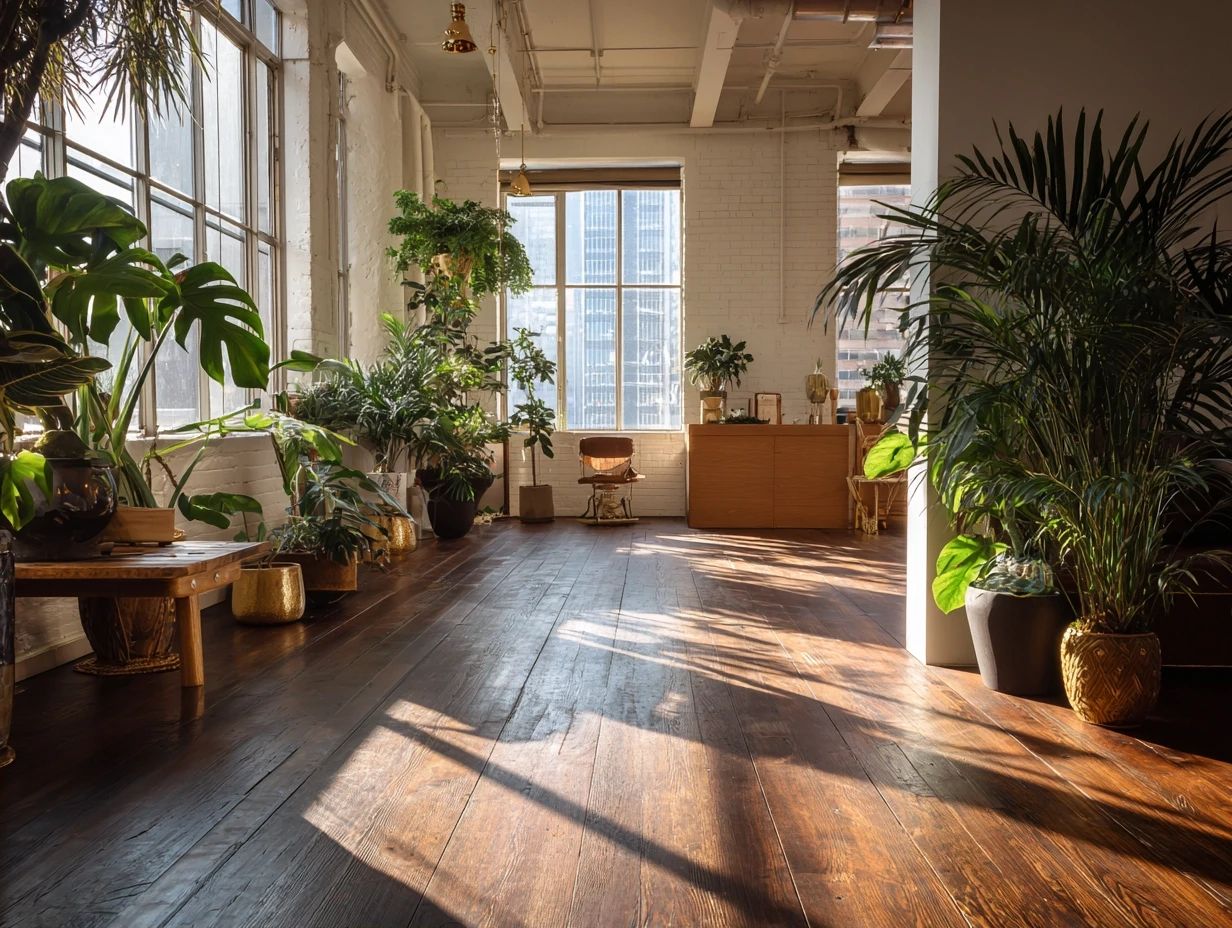
Natural flooring encompasses materials like hardwood, bamboo, and stone, offering unmatched comfort and aesthetic appeal in interior design.
These materials are stylish, durable, and environmentally friendly. For instance, bamboo is a rapidly renewable resource, growing up to three feet in 24 hours and requiring minimal chemicals during production.
The Sustainable Furnishings Council says that 75% of buyers like eco-friendly products, so natural flooring is a popular pick for today’s homes. Hardwood can last a lifetime when properly maintained, and it often adds value to a property, appealing to both homebuyers and renters alike.
Types of Natural Flooring Materials
Various natural flooring materials, including hardwood, bamboo, and cork, each bring unique benefits and aesthetic qualities to interiors.
Hardwood offers durability and timeless elegance, available in species like oak or maple, typically costing $5-$15 per square foot.
Bamboo is an eco-friendly choice, harvested periodically, costing between $3 and $8 per square foot, and has a modern look.
Cork, known for its comfort and sound-dampening properties, ranges from $2-$7 per square foot and is ideal for kitchens and play areas.
When choosing, consider your lifestyle, desired aesthetics, and budget to find the perfect fit for your home.
Wood Flooring
Wood flooring is a timeless option in biophilic design, valued for its natural warmth and ability to fit into different design styles.
Types of Wood and Their Benefits
Different types of wood, from oak to bamboo, offer unique benefits, including durability, sustainability, and aesthetic appeal.
Oak is a traditional option for indoor areas. The wood is durable and has an attractive grain, ideal for furniture and flooring.
Alternatively, bamboo is an eco-friendly option, growing rapidly and producing a striking look, perfect for modern designs. Softwoods like pine are cost-effective and easy to work with, suitable for accent pieces.
When selecting wood, consider your budget and the environmental impact; bamboo and reclaimed wood are excellent sustainable choices, while oak, although pricier, contributes to long-lasting quality.
Installation and Maintenance
Correct installation and care of wood flooring are important for extending its life and keeping it looking good. It helps in its long-term use.
- To begin, let the wood planks sit in the room for at least 48 hours so they can adjust to the temperature and humidity.
- Use a moisture meter to check the subfloor’s moisture level-ideally below 12%.
- After installation, maintain your floors by sweeping or vacuuming regularly to prevent dirt accumulation.
- Use a damp mop with a wood-safe cleaner monthly to keep the surface clean.
Avoid heavy furniture in high-traffic areas and consider placing felt pads under furniture legs to prevent scratches. Regular inspections can help catch potential issues early.
Stone Flooring
Stone flooring brings the natural look and strength of the outdoors inside, showcasing the principles of nature-inspired design with its natural features.
Types of Stone and Their Benefits
Stone flooring options, including granite and marble, offer durability and a unique aesthetic that complements biophilic design effectively.
Granite is valued for its durability, which makes it great for busy areas, while marble adds a classy look but needs more upkeep.
Both stones can improve indoor spaces; however, granite resists scratches, making it a good choice for kitchens, while marble’s glossy finish suits living rooms.
Regular sealing and cleaning with a pH-neutral stone cleaner are essential to maintain their beauty.
When choosing, consider the room’s function-select granite for functionality and marble for a touch of luxury.
Installation and Maintenance
Proper installation and care of stone floors can extend their lifespan and keep them looking beautiful in your home.
- First, check that the subfloor is tidy, dry, and level.
- Use a high-quality thin-set mortar for the installation, as it provides a strong bond.
- After laying the stone, apply a penetrating sealer to protect against stains and moisture.
- Regular maintenance involves sweeping and mopping with pH-neutral cleaners to avoid damaging the natural finish.
- If you encounter scratches or chips, use a specialized stone filler to restore the surface.
This proactive approach will keep your stone flooring looking stunning for years to come.
Cork Flooring
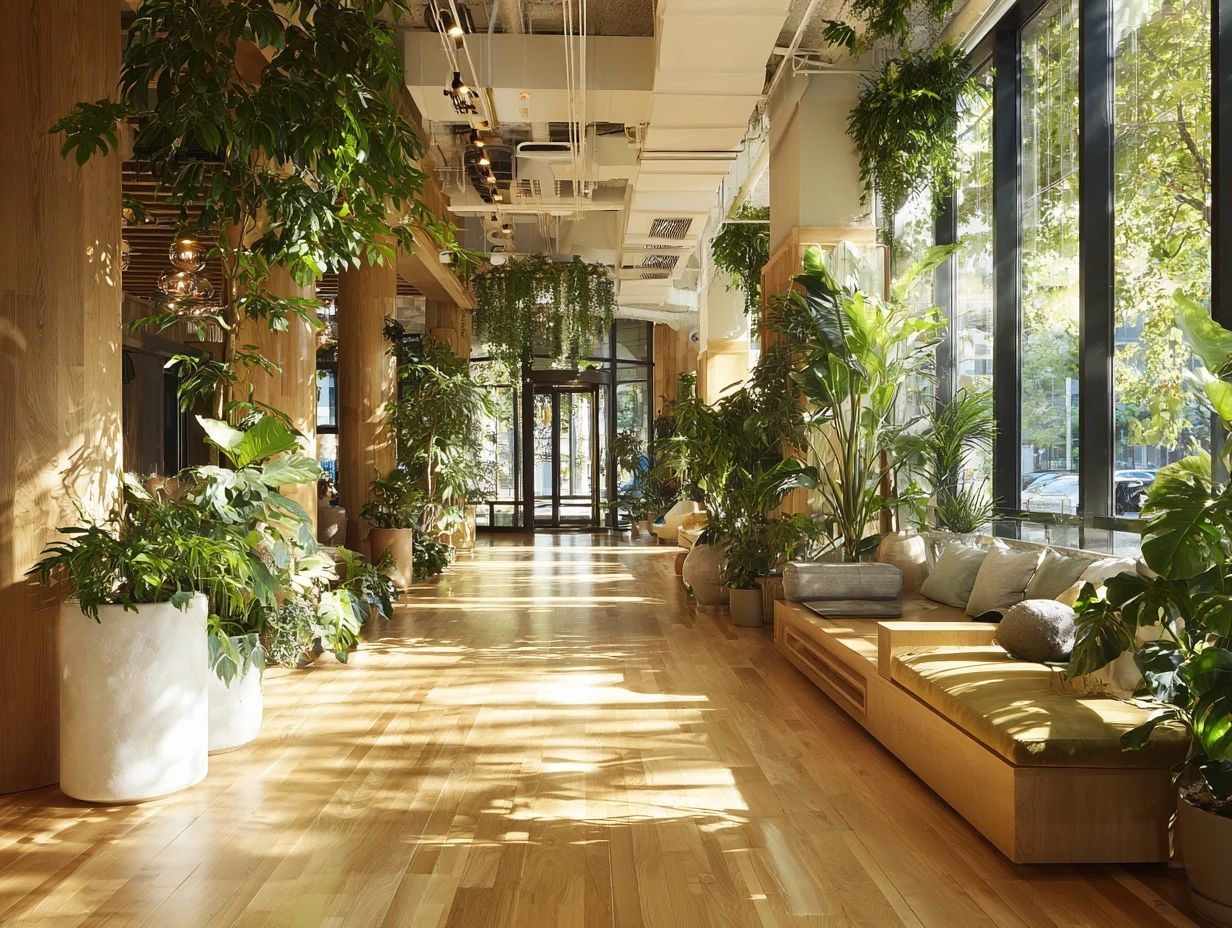
Cork flooring is becoming more popular as an environmentally-friendly choice that provides comfort and helps with heat insulation in nature-inspired design.
Benefits of Cork as a Natural Material
Cork flooring offers many advantages, including great thermal insulation, sound dampening, and resistance to mold and mildew.
Cork is an eco-friendly material, harvested from the bark of cork oak trees without harming the tree, promoting sustainability. It is hypoallergenic, so it’s a good choice for homes with allergies or breathing problems because it doesn’t hold onto dust or pollen.
When considering maintenance, cork requires minimal upkeep; a simple regular sweeping and occasional mopping are usually sufficient. Apply a sealant every few years to protect the surface from scratches and stains, helping it last longer.
Installation and Maintenance
Putting in and taking care of cork flooring needs certain methods to keep it lasting and environmentally friendly over time.
- First, prepare the subfloor by ensuring it’s clean and dry. Then, acclimate the cork planks for at least 48 hours in the room where they will be installed to prevent expansion or contraction.
- For installation, use a floating floor method with an underlayment to reduce noise and moisture.
- After installation, regular maintenance is essential. Clean with a damp mop and a pH-neutral cleaner, avoiding excess water. Applying a sealant every few years helps maintain the cork’s appearance and guards against spills.
Integrating Natural Flooring in Biophilic Design
Using natural flooring in biophilic design needs careful choice of materials that match the design goals.
Design Considerations
Key design considerations include selecting appropriate materials, maintaining cohesion with natural light, and ensuring comfort in space utilization.
To effectively integrate natural flooring, choose sustainable options like bamboo or reclaimed wood, which add warmth and character.
For example, a successful project by designer Sarah Smith used wide plank oak floors along with large windows to fill the space with light, highlighting the wood’s natural colors.
Think about using acoustic underlayment to improve comfort, especially in open-plan homes. This well-considered method improves the look and makes the area inviting, ensuring your space is both attractive and practical.
Case Studies
Examining case studies of biophilic design reveals effective strategies for integrating natural flooring within diverse interior spaces.
A good example is the Green Building in Portland, Oregon, which used reclaimed wood flooring to improve warmth and sustainability. The design team aimed to create a calming atmosphere, achieving this with large windows and natural light.
Another case study involves a New York City office that integrated bamboo flooring, promoting a modern aesthetic while reducing environmental impact. Here, the flooring choice also helped improve acoustics, essential for a busy work environment.
Both projects show that choosing the right natural materials improves design and helps achieve environmental goals.
Biophilic Design and Natural Flooring Trends
Biophilic design is set to grow, with new developments in eco-friendly materials and more people recognizing the advantages of nature.
Emerging materials like reclaimed wood, cork, and bamboo are gaining traction for flooring, offering aesthetic warmth while minimizing environmental impact.
Design methods are changing to include living walls and natural light, blurring the line between indoor and outdoor spaces.
Companies such as Interface are leading the charge with their modular carpets made from recycled materials, while Ecotile promotes interlocking tiles from recycled rubber.
These new ideas reduce carbon emissions and offer a thorough way to improve health and sustainability in building design.
Biophilic Design Market and Economic Impact
Biophilic Design Market and Economic Impact
Biophilic Design Market Data: Market Growth
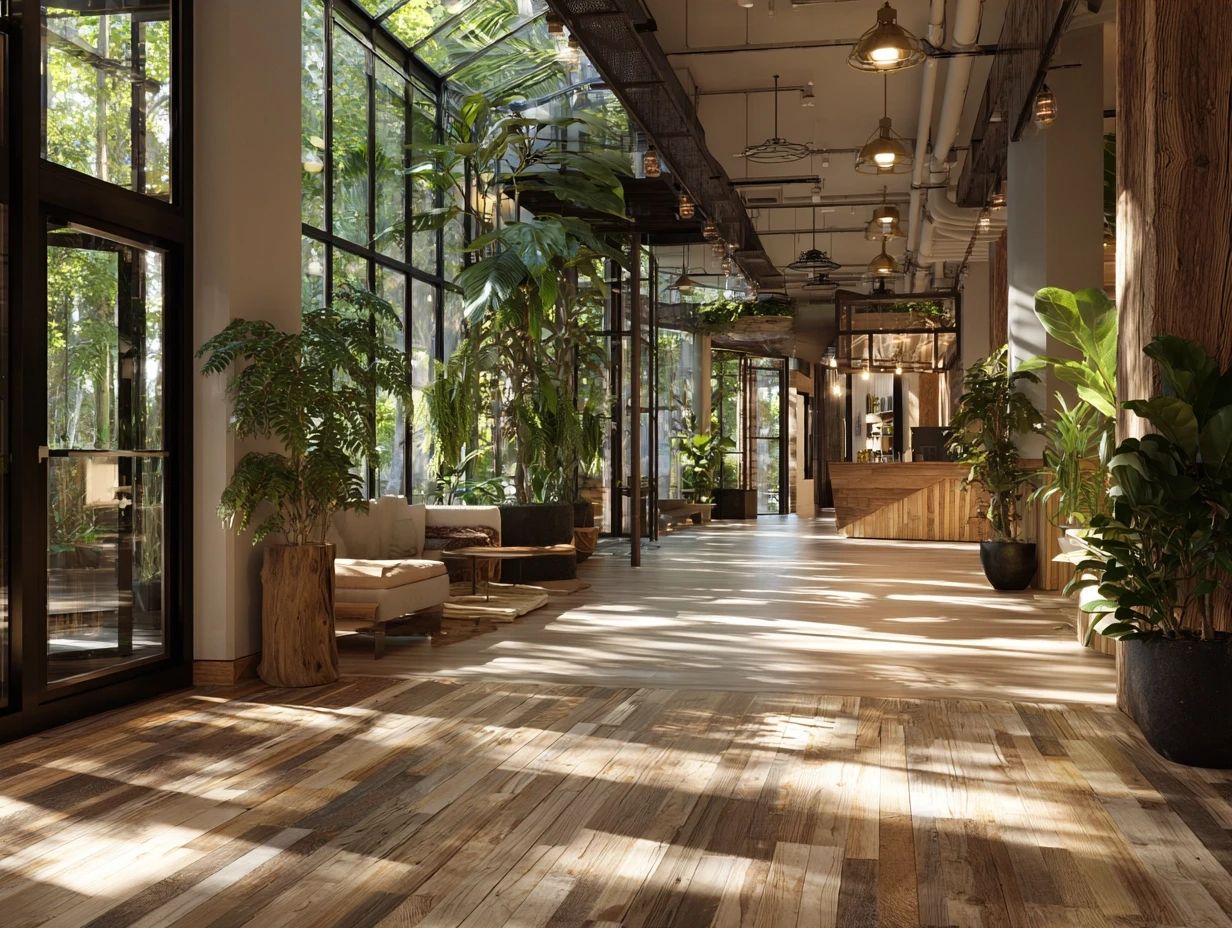
Biophilic Design Market Data: Employee Engagement & Retention
Biophilic Design Market Data: Cost Savings & Economic Impact
The Biophilic Design Market and Economic Impact Research shows the increasing significance of biophilic design in today’s architecture and businesses, highlighting its economic and human-centered advantages. The global market for biophilic design is projected to reach a value of $3.14 billion by 2028, reflecting a robust compound annual growth rate (CAGR) of 10.2% from 2023 to 2028. This growth is fueled by the increasing recognition of the benefits that biophilic design brings to human health, well-being, and productivity.
Focusing on Employee Engagement & Retention, a significant 84% believe in improved well-being Including nature-inspired designs in offices can improve how employees feel and increase their happiness. Additionally, 75% are willing to pay a premium for biophilic-designed spaces, indicating a strong market demand and opportunity for developers and businesses to capitalize on this preference.
- The data reveals a 10% reduction in sick leave, suggesting that biophilic environments contribute to healthier, more resilient employees. This reduction leads to increased work output and reduced healthcare expenses for employers.
In terms of Cost Savings & Economic Impact Biophilic design improves employee well-being and saves money. US hospitals have saved $93 million annually by incorporating biophilic elements, demonstrating substantial potential in healthcare settings to improve patient outcomes and operational efficiency. ING Bank reports annual savings of $2.6 million due to increased employee productivity and reduced absenteeism, highlighting the economic advantages of investing in biophilic design for corporate settings. Moreover, a Sacramento call center experienced a notable productivity gain quantified by a monetary value of $2,990, further emphasizing the design’s impact on enhancing workforce efficiency.
The biophilic design market is set to grow significantly, supported by its clear advantages in boosting well-being, cutting operational expenses, and improving financial results. As awareness and demand grow, industries in different fields will probably start using biophilic principles to create healthier, more productive, and economically sustainable environments.
Frequently Asked Questions
What is biophilic design and how does it relate to natural flooring materials?
Biophilic design is a way of making spaces that include natural elements to boost the health and well-being of people who use them. This can include using natural flooring materials such as wood, stone, or bamboo.
Why is biophilic design gaining popularity in the design world?
Biophilic design is becoming more common due to its beneficial effects on physical and mental health. It has been shown to reduce stress, improve mood, and increase productivity in various settings.
What are some examples of natural flooring materials used in biophilic design?
Common examples of natural flooring materials used in biophilic design include cork, wool, sisal, and jute. These materials are all environmentally friendly and can add a touch of nature to any space.
Are there any sustainability benefits to using natural flooring materials in biophilic design?
Yes, natural flooring materials are often more sustainable than synthetic materials. They are typically made from renewable resources and can be recycled or biodegraded at the end of their lifespan, reducing their impact on the environment.
What should I consider when choosing natural flooring materials for a biophilic design?
When selecting natural flooring materials, it’s important to consider the durability, maintenance needs, and cost. It’s important that the materials are sourced in an environmentally friendly way and comply with safety requirements.
Can biophilic design and natural flooring materials be used in any space?
Yes, you can add biophilic design to any area, whether it’s a home, office, or public space. Natural flooring materials can be used in many places to make a space feel more connected to nature.
